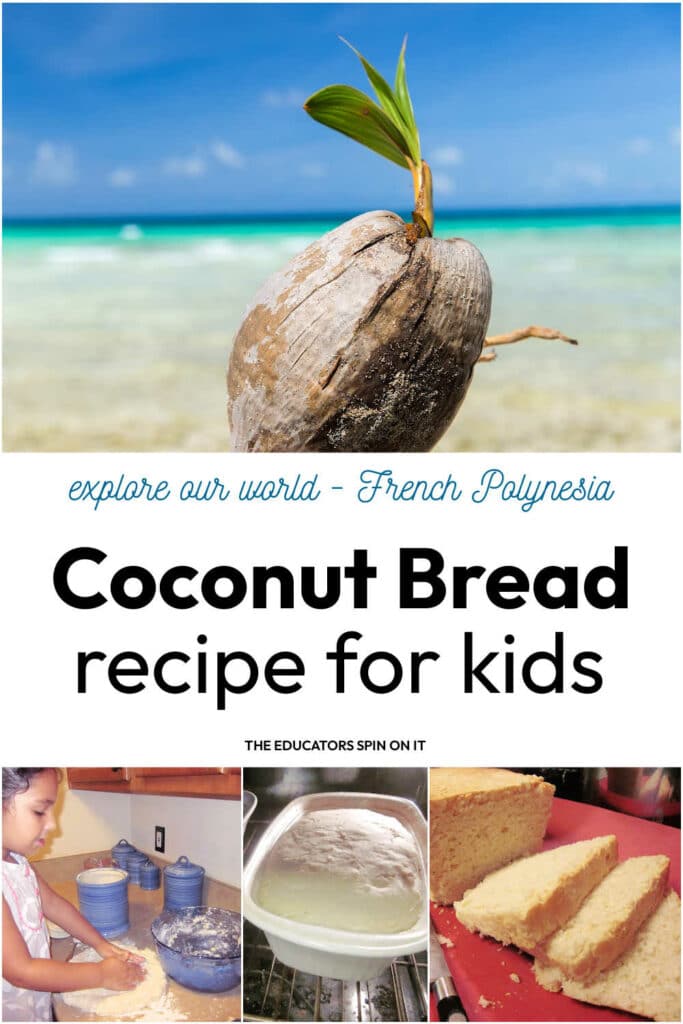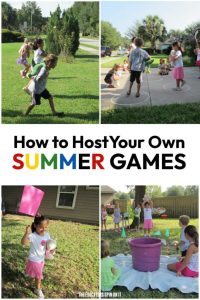
Coconut Bread Recipe for Kids from French Polynesia
Create coconut bread as you explore French Polynesia with your kids in the kitchen. We’re traveling the world through activities and recipes and invite you to join the fun.

Welcome back to “Around The World in 12 Dishes”. We’ve arrived in French Polynesia on our journey around the world, (loosely) following in Phileas Fogg’s footsteps, exploring 12 different countries with our children, by cooking 12 dishes with them. One for each country visited.
Here’s where we’ve traveled so far on our Cooking Around the World.
Now we’re heading to the beautiful islands of French Polynesia!

Learning about French Polynesia with Kids
We decided to make Coconut Bread for our Dish. It’s a moist and sweet bread with very few ingredients. According to our research, coconut bread is popular at both breakfast and lunch in Tahiti, Moorea, and Bora Bora.
French Polynesia consists of 121 islands and atolls (75 inhabited) in the South Pacific Ocean. The total land area is 3,521 square kilometers. The population of 278,786
The capital is Tahiti. Some other important atolls, islands, and island groups in French Polynesia are: Ahē, Bora Bora, Hiva ‘Oa, Huahine, Mai’ao, Maupiti, Meheti’a, Mo’orea, Nuku Hiva, Raiatea, Taha’a, Tetiaroa, Tupua’i and Tūpai.

Tahitian Island Cooking by Jean Galopin
The recipe we chose came from the cookbook Tahitian Island Cooking by Jean Galopin. We weren’t able to find the book but would love to get our hands on it one day to find more Tahitian recipes.

Tahitian Coconut Bread Recipe
Cook Time:
35 minutes but you need to let the bread rise 3 hours first so plan ahead!
Ingredients:
- 1 tablespoon melted butter
- 1 and 1/2 cups of water
- 2/3 cup granulated sugar
- 8 cups all-purpose flour
- 2 teaspoons yeast
- 2 cups coconut milk
For the Recipe, we followed Click here.
Here’s another version too!

My daughter was in charge of measuring all of the ingredients for this recipe. They were pretty simple and I was there to assist her if she needed help.
Here she is pouring the water, measuring the flour, and stirring the ingredients in both steps.
Then the fun part begins when it’s time to knead the bread. She had fun getting sticky and gooey and learned that flour does help the process. Although it might not be the most proper form of kneading, she really was starting to understand the process. Then we waited and watched how the dough changed because of the yeast in it.
We let it rise for 3 hours so we had some time for learning about the islands.
Next on our list to make is this moist and flavorful Coconut Cake topped with a sweet and creamy coconut buttercream frosting.

Learning How Foods Were Brought to the French Polynesian Islands
While our bread was rising we took some time to talk about where the French Polynesia Islands are located. We discovered how many islands there were. My daughter still remembers her cruise to the Western Caribbean from a few years ago so it was fun to talk with her about island hopping and all that there is to do and see on an island.
One of our day trips was focused on the foods of the islands, this was probably our favorite of all the islands we visited.
One thing that we talked about was how the food got to the island. Since all the islands of French Polynesia are of volcanic origin, what created isolated and sparse islands, far away from any continent? Where could the food come from?

We discovered there were so many plants but that most of the fruits and vegetables were imported and acclimated by people. There were two groups that sailed to the islands.
- Polynesian immigrants -who may have come from Southeast Asia- brought on their canoes the typical fruits of their region that they needed to survive during their long trip across the Pacific Ocean: banana trees, coconut trees, breadfruit trees… Those plants are considered today by many people as indigenous.
- European colonists then brought many species that they had gathered all around the world and acclimated them with success to the Polynesian climate. That is why we can find today in Polynesian gardens, orchards and mountains either European strawberries, African watermelons, Brazilian guava trees, or grapefruits from Borneo…
Source: The Tahiti Traveler

We learned about the names of the Fruits and Vegetables that can be found on the islands. It was fun to see how many are also found in Florida and in India… all very close growing to a similar relation to the equator.
We checked on our globe the latitude of each place we have our family.

Becky at Kid Citizen World inspired us with her post about food and Maps, go check it out. See how much you can learn with cooking!
Once our bread was done rising we gently popped it into the oven for just 35 minutes. When it came out of the oven my daughter was so excited that it really looked like bread that she made on her own. We all had a taste test and it was so yummy.
I can imagine it with even some delicious island fruit on top for breakfast or lunch or perhaps with this Jam.

We had so much fun making this bread together and learning about the islands of French Polynesia. We even checked out a few Tahitian videos online and read a few books about the Islands.
Plus we made a small bungalow craft and a little science lesson about coconuts while the dough was rising. Now it’s your turn to share with us!

How to join the fun!
- Cook a dish from French Polynesia: The goal is to explore this country through FOOD and activities if you wish. Make a typical dish (sweet or savory) from the country with the kids, take photos and have fun!
- Typical dishes: Poisson Cru, Poulet (Chicken) Fafa, Po’e, Pork Curry with Tarua (Taro), .
- Make a craft: you can make a country-related craft with the kids [optional!]
- Fun fact: Those things that look like mailboxes outside the homes of Tahitian residents are not for mail but for French bread delivery. Residents get a fresh loaf dropped off twice a day. But they must go to the post office to retrieve their mail!
Just in case you’re not quite ready for Summer to be over take one last peek at these beautiful islands of French Polynesia!
Want more ideas for cooking with kids? Try these kid-friendly recipes…






Average Rating